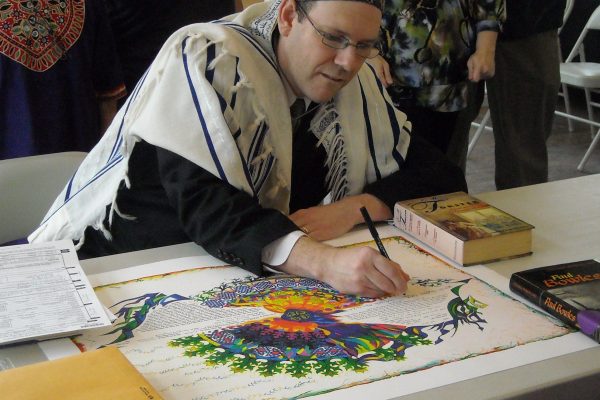Lieberman Clause
In 1953 the Rabbinical Assembly and the Jewish Theological Seminary accepted an additional clause in the ketubah proposed by Professor Saul Lieberman. The purpose of the Lieberman takanah was to help solve the problem of agunot (women whose husbands refuse to grant them a religious divorce and who are thus prohibited from remarrying). The bride and groom agree to recognize the authority of the Bet Din of the Rabbinical Assembly and the Jewish Theological Seminary to summon either party at the request of the other to enable the party so requesting to live in accordance with the Torah. The point of this clause is to exert moral suasion upon a recalcitrant spouse already divorced under civil law to agree to a traditional get.
In 1991, the Joint Bet Din of the Conservative Movement suggested the couple sign a letter of intent in addition to the clause in the ketubah. The wording was worked out in order to ensure its viability in American courts.
The Aramaic and English texts of the Lieberman Clause and the Letter of Intent follow. Please consult with your rabbi about this issue.
This paragraph appears as the penultimate paragraph in the ketubah:
Transliteration:
U’tzvi’u mar ________ bar ______ khatam d’nan u’marat _________ bat ______ da d’in ya’sik adata kh’khad minhon l’natokey nisueyhon o’ in itnatuk nisueyhon b’arkhaot dimdinta d’yikhol din o’ da l’zamana l’khavrey l’vey dina dikhnista drabanan u’dveyt madr’sha d’rabanan d’arata dikyama o’ man d’atey min khaley v’leytzutu tarvayhu l’fiska d’diney b’dil d’yiklu tarvayhu l’meykhey b’diney d’or’raita.
_______________, the groom, and __________, the bride, further agreed that should either contemplate dissolution of the marriage, or following the dissolution of their marriage in the civil courts, each may summon the other to the Bet Din of the Rabbinical Assembly and the Jewish Theological Seminary, or its representative, and that each will abide by its instructions so that throughout life each will be able to live according to the laws of the Torah.
Letter of Intent
Each of us has met with Rabbi _________, who has provided us with a copy of the ketubah (a copy of which is attached) and explained to each of us the provisions contained in the ketubah concerning the dissolution of marriage.
Each of us acknowledges and confirms our understanding that this ketubah is a legal contract and shall be binding under both Jewish and civil law concerning the formation and dissolution of our marriage.
In particular, each of us acknowledges that according to this ketubah, should our marriage be dissolved in the civil courts, each of us is bound to appear before the Joint Bet Din of the Conservative Movement, or such Bet Din as shall be designated by the Joint Bet Din, if so requested by the other, and to abide by its instruction and decision with respect to the dissolution of our marriage under Jewish law. Each of us intends that the undertaking to appear before and to be bound by the directions of the Bet Din may be enforced by the civil court of law. Each of us acknowledges our agreement to the ketubah and our willingness to be bound by its terms.
Dated ________________________
Signature of Bride ____________________
Signature of Groom _____________________
Explained and signed under the supervision of Rabbi _____________________
Signature of Rabbi__________________________________












